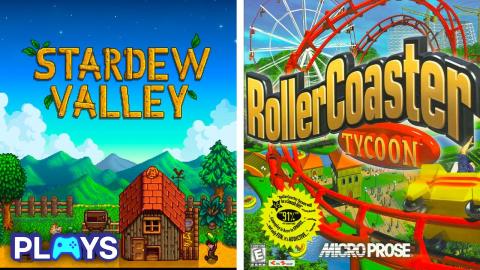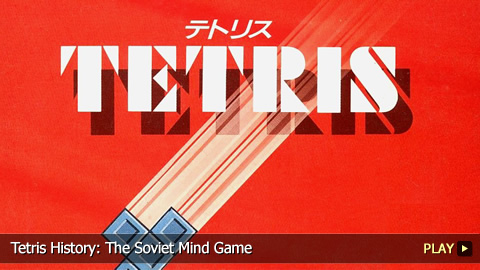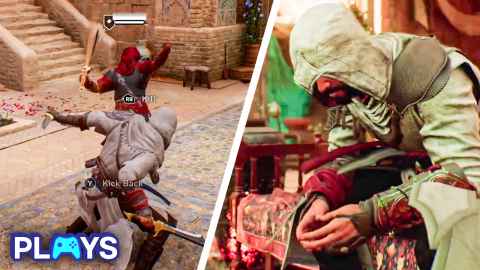10 Video Games Created By A SINGLE Person

“Getting Over It With Bennett Foddy” (2017)
Top 10 Scariest First Person Horror Games
Some creators relish the challenge of video games and in turn create video games solely focused on players overcoming difficult obstacles, but Getting Over It With Bennett Foddy takes these aspirations to an entirely new level. Much like his first hit QWOP, Bennett Foddy’s next success Getting Over It is specifically designed to frustrate the player as they attempt to guide a man in a cauldron armed only with a sledgehammer up ever increasingly obscure and ridiculous obstacles to reach the top, all while Bennett himself narrates the player through their many failed attempts. With no checkpoints and a complete restart only one mis-jump away, many were forced to get over it, and it led to the continued success for Mr. Foddy.
“Lethal Company” (2023)
Top 10 Best Non-Lethal Weapons in Video Games
Unintentionally the funniest game of the year, Lethal Company has become a viral hit due to the community and players simply reacting to the world and its mechanics. What could have been a simple extraction game in which players must collect as many materials as possible while avoiding all manner of ever-increasing SCP dangers took the internet by storm due not only to the fun concept but the use of the game’s proximity chat. Players simply trying to survive the many environments turn simple encounters into laugh-out-loud sitcoms. Created by lone developer Zeekerss, even though the game is still in early access, the fan base continues to grow and with consistent content updates, while new players are constantly discovering new mysteries and creatures hiding on the various moons.
“Tetris” (1988)
Tetris History: The Soviet Mind Game
The most recognized and influential puzzle game of all time, Tetris was created by Russian developer Alexey Pajitnov whose main goal was to create games that “made people happy”. The simplistic nature of rotating blocks became an instant hit, aided by the inclusion of the game with the original release of Nintendo’s Gameboy handheld. Tetris remains one of the most popular and most ported games of all time albeit with some slight variations and updates, but the core gameplay loop remains unchanged from its original incarnation in 1988. The game became so addictive and popular within the halls of the Moscow Medical Institute, the game had to be banned for work to continue. One of the most widely studied and played games in the history of the medium, Tetris remains an industry icon and was all born from one man’s love of puzzles and a desire for people to have fun.
“Return of the Obra Dinn” (2018)
10 Assassin's Creed Features That RETURN In Mirage
Following the success of his first game Papers, Please, Lucas Pope’s next game Return of the Obra Dinn was far more ambitious but nonetheless equally engaging. Players are put in the role of an investigator sent to discover why the titular Obra Dinn went missing for 5 years and what happened to her crew. The player must piece together the events leading up to the ship's disappearance by peering into the past and discovering the fate of each of the ship’s 60 crew members. The game’s monochromatic art style was meant to recreate early Macintosh computer graphics and the game was praised for its art design and storytelling, with its unique approach to puzzles helping the game become a standout hit even against other AAA games of the same year.
“Iron Lung” (2022)
Earth Defense Force: Iron Rain Review - Just Another Spin-Off?
Proof that creative game design and excellent world building can create an engaging experience, players who take the plunge with Iron Lung are trapped inside the titular iron sub and must manually traverse the blood sea to capture photos of various structures with the promise of freedom once the task is complete. The game slowly gained a cult following with developer David Szymanski adding content updates that further explored the “Quiet Rapture” and all the lore in between. The foreboding atmosphere as well as the game’s outstanding sound design made it a hit with steamers, in particular Markiplier who announced he would be directing and starring in a live action adaptation of the game with direct input from Szymanski himself. Not bad for a solo developer’s first major hit.
“Cave Story” (2004)
Arguably one of the most successful single developer indie games of all time, Cave Story was created over a 5-year period by Daisuke Amaya in his spare time and went on to receive widespread acclaim for its story, characters, and its use of Metroidvania exploration. The player explores a massive cave system using a myriad of weapons to deal with the various enemies they encounter while attempting to recover their memories. Cave Story has since been ported numerous times to nearly every console, and still maintains a loyal fanbase 2 decades later and stands as testament to what a single developer can accomplish with enough love and dedication to their creation.
“Braid” (2008)
There’s no denying that Braid helped launch the success of the Xbox Live Arcade on the 360 back in 2008. Shortly after Braid’s success, the platform was inundated with hundreds of indie developers hoping their games would find a new audience outside of the PC marketplace. Braid success also lies in its design with Jonathan Blow using around $180,000 of his own money to complete the game’s development. The multi-layered narrative still has people discussing the game’s underlying themes and its use of time manipulation helped Braid create an identity all its own in a market flooded with 2D platformers. Braid not only helped launch the career of one of the best indie puzzle game creators but also initiated the boom of the indie market and helped put similar games on the map.
“Roller Coaster Tycoon” (1999)
Inspired by Sid Meier but nowhere near as well known, Chris Sawyer is one of the most important game developers you’ve probably never heard of. After finding great success with his game Transport Tycoon, Sawyer turned his newfound obsession with roller coasters into one of the most successful sim franchises of the late 90s and 2000s. Roller Coaster Tycoon gave players the tools to create their own theme park, roller coasters as well as other attractions while doing everything to keep attendees happy and entertained. The series became an overnight success and multiple expansions and sequels were also critical and commercial successes. Roller Coaster Tycoon remains one of the greatest success stories for a single developer in video game history.
“Stardew Valley” (2016)
It’s extremely rare for an indie game influenced by an established property to surpass the original, even more so for the original property’s creator praises the title that outdid them, but Stardew Valley (inspired by the farming sim series Harvest Moon and created by sole developer Eric Barone) has managed to become one of the most beloved indie games ever made. Players are given their own farm and numerous biomes to choose from, tasked with maintaining their crops, land, and relationships with the various townsfolk that inhabit the neighboring areas. The game’s simplistic pick up and play nature makes losing countless hours living out your digital life on the farm easy but also infinitely rewarding. Development became a full-time job for Barone, but the results far surpassed anything the devout Harvest Moon fan could have imagined.
“Undertale” (2015)
Kickstarter has launched many video game success stories over the years but by far Undertale is one of the biggest. Developed over the course of two and a half years by first time developer Toby Fox, the mad lad crafted nearly every aspect of Undertale by himself, including the game’s catchy soundtrack. Taking the traditional idea of RPGs and putting his own spin on the mechanics, Undertale instead encourages players to not engage in direct combat and choose the “Pacifist” route and find more peaceful solutions to encounters, although the game does allow for what is referred to as the “Genocide” run for those who want to embrave the dark side. With instantly iconic characters and a story that subverted all expectations, Undertale and Toby Fox are now immortalized for their contributions to the video game landscape, and rightly so. Have you ever wanted to create your own video game? Follow your dreams down in the comments.






